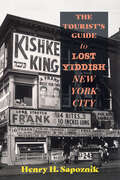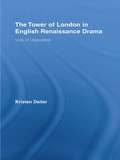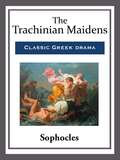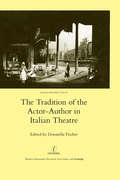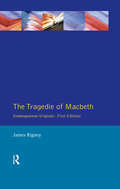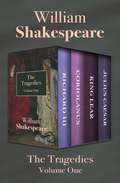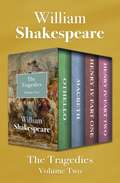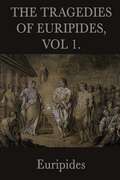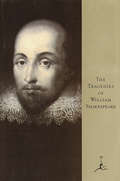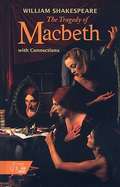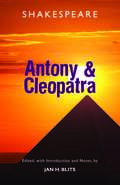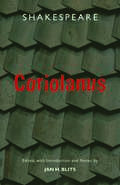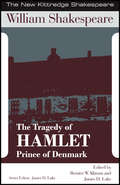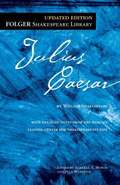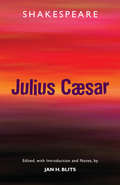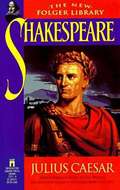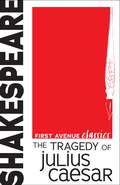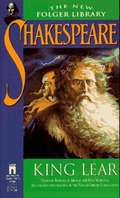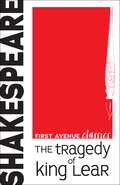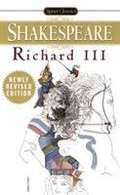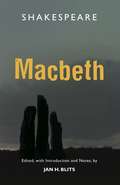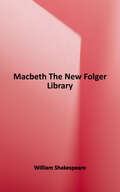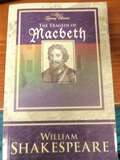- Table View
- List View
The Tourist's Guide to Lost Yiddish New York City (Excelsior Editions)
by Henry H. SapoznikA history of New York's Yiddish popular culture from 1880 to the present.The Tourist's Guide to Lost Yiddish New York City offers a new look at over a century of New York's history of Yiddish popular culture. Henry H. Sapoznik-a Peabody Award-winning coproducer of NPR's Yiddish Radio Project-tells the story in over a baker's dozen chapters on theater, music, architecture, crime, Blacks and Jews, restaurants, real estate, and journalism. Culled from over five thousand Yiddish and English newspaper articles of the period, and thanks to new research from previously inaccessible materials, the book reveals fresh insights into the impossible-to-overstate influence of Yiddish culture on New York City. Containing fifty images, many of which have never before been published, the book is complemented by an online interactive Google Map linked to over one hundred of the historic locations discussed in the book, with additional graphics and resource materials. The Tourist's Guide to Lost Yiddish New York City is a vivid, entertaining, and accessible compendium of both New York's lush Ashkenazic past and present, showcasing the culture's persistent resiliency.
The Tower of London in English Renaissance Drama: Icon of Opposition (Literary Criticism and Cultural Theory)
by Kristen DeiterThe Tower of London in English Renaissance Drama historicizes the Tower of London's evolving meanings in English culture alongside its representations in twenty-four English history plays, 1579-c.1634, by William Shakespeare, Christopher Marlowe and others. While Elizabeth I, James I, and Charles I fashioned the Tower as a showplace of royal authority, magnificence, and entertainment, many playwrights of the time revealed the Tower's instability as a royal symbol and represented it, instead, as an emblem of opposition to the crown and as a bodily and spiritual icon of non-royal English identity.
The Trachinian Maidens
by SophoclesThe Trachinian Maidens' (also 'Women of Trachis' or 'The Trachiniae') is an Athenian tragedy by Sophocles, in which Deianeira, the wife of Heracles, is distraught over her husband's neglect of her family. Unable to cope with the thought of losing him, she decides to use a love charm on him, a magic potion that will win him back.
The Tradition of the Actor-author in Italian Theatre
by Donatella Fischer"The central importance of the actor-author is a distinctive feature of Italian theatrical life, in all its eclectic range of regional cultures and artistic traditions. The fascination of the figure is that he or she stands on both sides of one of theatre's most important power relationships: between the exhilarating freedom of performance and the austere restriction of authorship and the written text. This broad-ranging volume brings together critical essays on the role of the actor-author, spanning the period from the Renaissance to the present. Starting with Castiglione, Ruzante and the commedia dell'arte, and surveying the works of Dario Fo, De Filippo and Bene, among others, the contributors cast light on a tradition which continues into Neapolitan and Sicilian theatre today, and in Italy's currently fashionable 'narrative theatre', where the actor-author is centre stage in a solo performance."
The Tragedie of Macbeth: The Folio of 1623 (Timeless Shakespeare)
by James RigneyThe Shakespearean Originals Series takes as its point of departure the question: "What is it that we read Shakespeare?" The answer may seem self-evident: we read the words that Shakespeare wrote. But do we? In the case of all the major editions of Shakespeare available in the market, the fact of the matter is that many of the words that we read in an edition of, say, Hamlet, never appeared in the text as it was printed during or shortly after Shakespeare's own lifetime. They are the interpetations and interpolations of a series of editors who have been systematically changing Shakespeare's text from the eighteenth century onwards. This volume offers the text of Macbeth, as printed in the 1623 First Folio.
The Tragedies Volume One: Richard III, Coriolanus, King Lear, and Julius Caesar (The\complete Works Of Shakespeare Ser.)
by William ShakespeareThese timeless plays by the great Bard of Elizabethan drama explore the hubris of four powerful men who ultimately bring about their own undoing.Richard III: Through coldblooded guile, hunchbacked royal Richard III assumes the throne of England and will stop at nothing to maintain his rule. But he will pay a price for his machinations in this historical play set in the era of the Wars of the Roses.Coriolanus: The common people of the Roman Republic are rebelling against the elite, but war hero Coriolanus has no patience for those he considers beneath him. When this contempt leads to his exile, his thirst for revenge threatens the very state he once served.King Lear: An aged king attempts to shake off his responsibilities while retaining his stature. Rewarding the flattery of his two elder daughters even as he banishes his youngest for speaking the truth, Lear is led into exile and madness as his country descends into civil war.Julius Caesar: Roman generalJulius Caesar is basking in the glow of military triumph—but his friend Brutus has fallen in with a band of conspirators who argue the general&’s ambitions may soon give way to tyranny. Agreeing to join in Caesar&’s assassination, Brutus&’s betrayal unleashes tragic consequences.
The Tragedies Volume Two: Othello, Macbeth, Henry IV Part One, and Henry IV Part Two
by William ShakespeareFour plays by the revered Elizabethan dramatist tell of men driven to evil by ambition and jealousy—and of one who escapes the dangers of bad influence.Othello: A powerful general in the Venetian army, Othello the Moor is despised by his scheming ensign, Iago, who devises a plan to destroy him. Newly married to Desdemona, Othello is led to believe she has been unfaithful—and his jealous rage leads to tragic consequences.Macbeth: When three witches foretell that Macbeth will be king of Scotland, he does not wait for destiny to run its course. Instead, he and his wife plot to kill the presiding king, an act that will realize their ambitions—and bring them to ruin.Henry IV Part One: This historical play chronicles the rebellions faced by the medieval king of England Henry IV, as well asthe maturation of his son, Prince Hal.The prince indulges in a carefree life with the comical rogue Falstaff but must eventually cast aside his recklessness and live up to his royal destiny.Henry IV Part Two: As Henry IV&’s health grows weaker, Prince Hal&’s ability to assume the crown remains in doubt. The prince&’s friendship with the drunk and thieving Falstaff threatens to be his undoing. Now he faces a choice that will determine not only his own future, but also that of England
The Tragedies of Euripides
by EuripidesIn this volume of Euripides tragedies you will find the pays Hecuba, Orestes, The Phúnician Virgins, Medea, Hippolytus, Alcestis, The Bacchae, The Heracleidae, Iphigenia in Aulis, and Iphigenia in Tauris.
The Tragedies of Shakespeare
by William ShakespeareContains the complete text of such Shakespeare tragedies as Romeo and Juliet, King Lear, and Macbeth.
The Tragedy Of Macbeth: With Connections (Holt McDougal Library, High School With Connections Ser.)
by William Shakespeare Holt StaffThe Holt McDougal Library includes a mix of fiction, nonfiction, drama, poetry, and biographies from a variety of reading levels for use as part of classroom curriculum or independent reading. Students will find selections they love in this extensive collection.
The Tragedy of Antony and Cleopatra (New Kittredge Shakespeare Ser.)
by William Shakespeare"This edition of Antony and Cleopatra gives contemporary readers access to Shakespeare’s meaning as no other edition does. While other editors may provide basic information about the historical setting of the play, Jan Blits makes palpable the shape and feel of the world in which the action unfolds. His annotations citing classical authors reveal a world of possibility that would have been available to earlier generations, that Shakespeare would have taken for granted, and that is lost on readers today. His excellent Introduction frames the drama in terms of questions regarding the relative place of the public and private in the polity’s life, the claims of the universal and the national on the allegiance of citizens, and the meaning of nobility that will be highly provocative for anyone interested in Shakespeare as a political thinker." —Joseph Alulis, North Park University
The Tragedy of Coriolanus (Focus Philosophical Library)
by William ShakespeareIntended for a wide audience, Jan Blits&’s edition of Shakespeare's The Tragedy of Coriolanus differs from other such editions by focusing upon ancient sources to highlight the play&’s setting during the founding of the Roman Republic. In doing so it sheds new light on both the action of the play and the historical and political significance of its setting.
The Tragedy of Hamlet, Prince of Denmark
by William Shakespeare Bernice W. Kliman James H. LakeGeorge Lyman Kittredge's insightful editions of Shakespeare have endured in part because of his eclecticism, his diversity of interests, and his wide-ranging accomplishments, all of which are reflected in the valuable notes in each volume.These new editions have specific emphasis on the performance histories of the plays (on stage and screen).Features of each edition include: The introduction to the original Kittredge Edition Editor's Introduction to the Focus Edition. An overview on major themes of the plays, and sections on the play's performance history on stage and screen. Explanatory Notes. The explanatory notes either expand on Kittredge's superb glosses, or, in the case of plays for which he did not write notes, give the needed explanations for Shakespeare's sometimes demanding language. Performance notes. These appear separately and immediately below the textual footnotes and include discussions of noteworthy stagings of the plays, issues of interpretation, and film and stage choices. How to read the play as Performance Section. A discussion of the written play vs. the play as performed and the various ways in which Shakespeare's words allow the reader to envision the work "off the page." Comprehensive Timeline. Covering major historical events (with brief annotations) as well as relevant details from Shakespeare's life. Some of the Chronologies include time chronologies within the plays. Topics for Discussion and Further Study Section. Critical Issues: Dealing with the text in a larger context and considerations of character, genre, language, and interpretative problems. Performance Issues: Problems and intricacies of staging the play connected to chief issues discussed in the Focus Editions' Introduction. Select Bibliography & Filmography Images from major productions, for comparison and scene study.
The Tragedy of Julius Caesar
by William Shakespeare Barbara A. Mowat Paul WestineThis edition, while retaining many of the features that have always made the Folger Shakespeare so attractive to the general reader, at the same time reflects these current ways of thinking about Shakespeare. For example, modern readers, ac¬tors, and teachers have become interested in the differ¬ences between, on the one hand, the early forms in which Shakespeare's plays were first published and, on the other hand, the forms in which editors through the centuries have presented them. In response to this interest, we have based our edition on what we consider the best early printed version of a particular play (ex¬plaining our rationale in a section called "An Introduc¬tion to This Text") and have marked our changes in the text--unobtrusively, we hope, but in such a way that the curious reader can be aware that a change has been made and can consult the "Textual Notes" to discover what appeared in the early printed version.
The Tragedy of Julius Caesar (Focus Philosophical Library)
by William Shakespeare Jan H. BlitsJan Blits' edition represents something new among editions of Julius Caesar. In addition to textual glosses and explanatory notes focused on the rhetorical, historical, and political contexts of the speeches, it includes a wide array of quotations and citations from writers of classical antiquity chosen to illuminate passages of special pertinence to the Roman world represented in the play. Highlighting Shakespeare's significance as a political thinker, it also demonstrates his deep understanding of Roman antiquity, its competing worldviews, and the demise of its Republic. Intended for a broad readership, the edition also includes a Preface, Introduction, Bibliography, and a topical Index.
The Tragedy of Julius Caesar (The Folger Shakespeare Library)
by William ShakespeareFOLGER Shakespeare Library: the world's leading center for Shakespeare studies. Each edition includes: * Freshly edited text based on the best early printed version of the play * Full explanatory notes conveniently placed on pages facing the text of the play * Scene-by-scene plot summaries * A key to famous lines and phrases * An introduction to reading Shakespeare's language * An essay by a leading Shakespeare scholar providing a modern perspective on the play.
The Tragedy of Julius Caesar with Connections
by William ShakespeareThis famous Shakespearean Tragedy underlines the human dynamics of leadership, it's risks, the development of treachery and the nature of betrayal.
The Tragedy of Julius Caesar: Large Print (First Avenue Classics ™)
by William ShakespeareMarcus Brutus, a Roman politician, considers Emperor Julius Caesar to be a friend, but a senator—Caius Cassius—convinces Brutus that Caesar has too much power. Brutus would rather Rome be a republic than an empire ruled by a tyrant, so he participates in a conspiracy to kill Caesar. Though Brutus believes his actions will benefit Rome, Caesar's murder brings about more bloodshed, including Brutus's own. The play examines friendship and patriotism, the succession of leadership, and the roles of fate and free will. Shakespeare wrote this drama, rooted in Roman history, in 1599; it was published in 1623, after Shakespeare's death. This is an unabridged edition of the tragic play.
The Tragedy of King Lear (First Avenue Classics ™)
by William ShakespeareKing Lear is growing old, and in an effort to preempt an inheritance war, he decides to divide his kingdom between his three daughters while he is still living—dependent on which one loves him the most. Goneril and Regan tell him flattering lies, but the youngest, Cordelia, refuses to answer. Angered, Lear disowns Cordelia. He splits the kingdom between Goneril and Regan, who begin plotting against him. When it becomes clear that the daughters who claimed to love him the most are planning to betray him and that he has banished the one daughter who truly loved him, Lear goes mad and wanders out onto the heath. This is an unabridged version of one of William Shakespeare's most famous tragedies. Versions of the play were first published in 1608 and 1623.
The Tragedy of King Richard the Third
by William ShakespeareWilliam Shakespeare's timeless tragedy follows the bloody path of the "rudely stamped" Richard, Duke of Gloucester, who uses his murderous guile to achieve the throne of England. This revised Signet Classics edition includes unique features such as: An overview of Shakespeare's life, world, and theater; A special introduction to the play by the editor; Selections from the source from which Shakespeare derived Richard III; Dramatic criticism; A comprehensive stage and screen history of notable actors, directors, and productions; Text, notes, and commentaries printed in the clearest, most readable text; And more...
The Tragedy of Macbeth
by William Shakespeare Jan H. BlitsThe fourth in a series of editions of Shakespeare&’s most political and history-soaked plays, this Macbeth offers copious aids to understanding the play not found in any other edition. By attending to the play&’s medieval Scottish setting in a way that rival editors have never matched—when they have even dug beyond the early seventeenth-century context in which it was produced—Jan H. Blits&’s edition richly rewards readers left unsatisfied by &“decodings&” of the play&’s supposed allusions to the politics of early modern England who wish to look deeper. In doing so, it opens the text for readers to encounter, in new ways, the play&’s historical, political, and psychological significance.
The Tragedy of Macbeth
by William ShakespeareWhen three witches tell Macbeth he will one day be king, he works to make sure their prophecy comes true.
The Tragedy of Macbeth (Literary Classics)
by William ShakespeareThis work has been selected by scholars as being culturally important, and is part of the knowledge base of civilization as we know it. This work was reproduced from the original artifact, and remains as true to the original work as possible. Therefore, you will see the original copyright references, library stamps (as most of these works have been housed in our most important libraries around the world), and other notations in the work. <p><p> This work is in the public domain in the United States of America, and possibly other nations. Within the United States, you may freely copy and distribute this work, as no entity (individual or corporate) has a copyright on the body of the work. <p><p> As a reproduction of a historical artifact, this work may contain missing or blurred pages, poor pictures, errant marks, etc. Scholars believe, and we concur, that this work is important enough to be preserved, reproduced, and made generally available to the public. We appreciate your support of the preservation process, and thank you for being an important part of keeping this knowledge alive and relevant.
